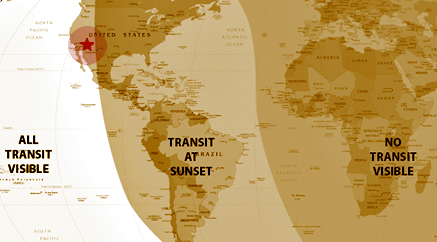
|
|
|||||||||||||||||||||||||||||
|
On November 8, 2006 , Mercury slowly slid across the face of the sun during an event known as a transit . A transit of Mercury is relatively rare—there are only about a dozen in a century. The Exploratorium’s expedition crew was at the Kitt Peak National Observatory, and, with the Kitt Peak staff, we Webcast the transit: a live five-hour telescope-only feed began at 11:00 am PST. The transit took place from 11:12 a.m. PST until 4:10 p.m. PST and was visible from the Pacific, the Americas, eastern Asia, Australia, and New Zealand, although some locations were not able to see the entire transit. Because of Mercury’s diminutive size, the transit couldn't be seen with the unaided eye, but it was visible with a telescope (with the proper filter) or by using a homemade optical projector . |
||||||||||||||||||||||||||||||
|
||||||||||||||||||||||||||||||
|
Our Webcast location, at Kitt Peak, Arizona, is marked with a red star.
Click the image above to view a larger version of the Mercury Transit map, or click here to download a PDF of the map. |
||||||||||||||||||||||||||||||
|
||||||||||||||||||||||||||||||
|
|
||||||||||||||||||||||||||||||
|
Transit of Mercury is made possible through the
generosity of the Gordon and Betty Moore Foundation, the Jim Clark Endowment for Internet Education, and the McBean Family Foundation. |
||||||||||||||||||||||||||||||
|
||||||||||||||||||||||||||||||

